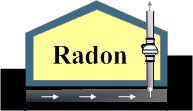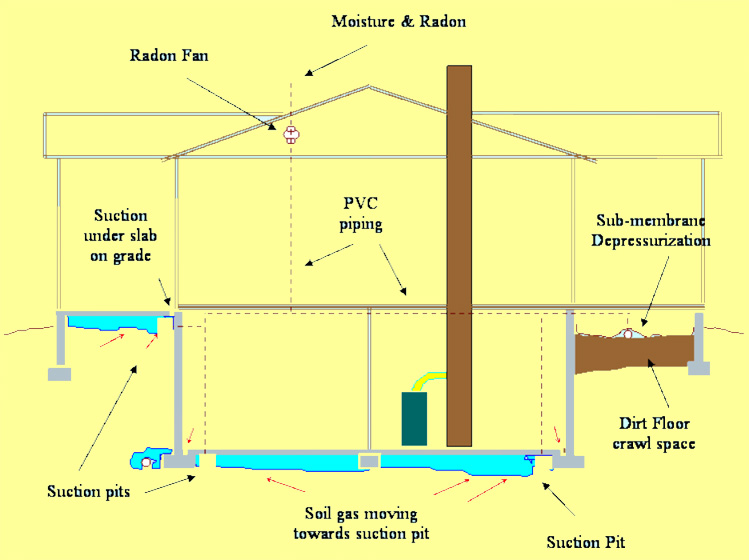 |
 |
Bill Brodhead WPB Enterprises Inc
Radon & Vapor Intrusion |
 |
 |
|
Bill Brodhead WPB Enterprises Inc.
Radon & Vapor Intrusion |
 |
 |
|
 |
What causes Basement Moisture?Can Radon Mitigation reduce this Moisture? |
 |
|
WPB Home page Radon Mitigation explanation Lots of additional info |
 |
What causes Basement Moisture?Can Radon Mitigation reduce this Moisture? |
 |
|
WPB Home page Radon Mitigation explanation Lots of additional info |
 |
|
During the twenty years we have been installing radon sub-slab depressurization systems clients have remarked that the basement is drier, the de-humidify runs less and typical basement odors disappear after the radon system is installed. Mold spores begin to rapidly multiply when there is little air movement and the relative humidity level goes above 60% and the temperatures are between 50 and 90 degrees F. But what are all the issues that cause a basement to have water problems and that musty odor. Scroll down to learn more about controlling basement moisture. |
|
There are four sources of basement moisture: 1) Occupant Activity using un-vented dryer, non-vented shower or breathing 2) Water Entry through the basement foundation or rising up through the slab 3) Infiltration of Outdoor Humid Air into the basement during the summer 4) Vapor Transfer from the soil into the basement through the slab or foundation
1. Occupant ActivityBreathing and plants induce some moisture into a home but not enough to cause excessive moisture problems. A dryer venting into a home is a bad idea even though you are recovering the heat. The moisture accumulation from the dryer into a laundry room could easily cause mold formation. Bathrooms should also be properly vented to the outside. 2. Water EntryWet basement foundation walls are often due to bad roof gutter systems and or grading problems. The roof collects a lot of water from rain water. Many wet foundation walls can be dried up if all the roof downspouts drained their water at least ten feet from the house to a location where it won't drain back to the house. If corner of a foundation wall is wet it is almost always the same corner where a downspout drops it's water next to the foundation. Clogged gutters, improperly sloped, downspouts emptying next to the foundation are all major culprits of wet foundation walls. Check all your gutters and downspouts and install piping to get that water away from the house.
Installing a sump pump Most concrete slabs have no moisture barrier under the slab. Sub-slab water that has risen to the bottom of the slab or moist soil that is in contact with a slab will induce significant capillary migration of water through the slab into the basement air. This is why the sump pump must be installed far enough below the slab to remove the sub-slab water before it rises to the bottom of the slab. To test a basement slab for capillary vapor transfer lay a rubber mat or poly sheet on the slab during a rainy period for a few days and see if moisture droplets collect on the barrier.
Basement De-Watering systems 3. Infiltration of Humid Outdoor AirThe University of Minnesota Extension Service estimates that normal household activity adds 8 to 16 pints of moisture to the indoor air every day. A typical humidifier adds 2 pints per hour. If you live east of the Rockies however, infiltration from outdoor warm humid air in the summer months can add 50 to 250 pints to the indoor air per day. So during the summer any infiltration increase to the basement will significantly increase the humidity and possibility of mold. Ventilating the basement for moisture reduction can only be done when the dew point is below the optimal indoor dew point.
Humidex
General Mold Information
The simplified psychometric chart above is used to determine the humidity in the air by measuring the temperature in the air for the bottom line and then measuring the temperature with the bulb of the thermometer in a wet wick. To determine how relative humidity changes with temperature go straight up from the bottom temperature until it intersects the humidity level defined by the curved lines. Now move horizontally to the desired temperature still represented by the bottom temperatures. The new position in relation to the curved lines is the new humidity. If the outdoor temperature is 70 degrees and 40% Relative Humidity (RH) and it enters a 55 degree basement (move horizontally from the 40% RH intersection with the 70 degree vertical line and the new humidity at 55 degree vertical line is above the 60% RH curved line. If we go up the 80 degree vertical line to half way between the 20% and 40% curved line or 30% RH and then horizontally over to the 55 degree vertical line we are also above the 60% RH level. This tells us that ventilating a 55 degree basement when the outdoor air is above 40% RH at 70 degrees or above 30% RH at 80 degrees will actually be adding 60% RH air. The point is: when it is warm and humid outside it can raise a basement to the level at which mold spores grow. Outdoor air entering a basement will always be less than 60% RH when the outdoor temperature is less than 42 degrees even if it is 100% RH outside (It's raining). So ventilation of basement to reduce moisture needs to be controlled differently depending on the season. It would not be appropriate for a radon mitigation system to induce year round increase of basement ventilation with outdoor air. Therefore radon mitigation systems that use active soil depressurization should minimize any removal of basement air by careful sealing of the slab or any barriers installed as a membrane depressurization. 4. Vapor Transfer from the SoilThe University of Minnesota Extension Service estimates that soil based moisture enteing the basement could be as high as 100 pints per day. Controlling soil moisture entry is therefore a major component in controlling basement moisture. This particularly would be the case if the basement humidity is elevated during the heating months when the outdoor air is drier. Many clients report to us that once a sub-slab depressurization system is activated the basement air quality improves.
Sub-Slab Depressurization affect A study done in NY state involved injecting a tracer gas in the soil three feet from eighty different houses. Monitors were set up in the basement to record the quantity that entered the house. No radon system was installed in these houses. On average 50% of the tracer gas ended up in the basement. This means that any chemicals such as might be applied by lawn fertilizing companies can easily enter a basement and then move up through the house. Installing a radon mitigation system prevents these possibly cancer causing chemicals from entering the home. A recent EPA funded research studied the effect of Moisture Reduction from ASD operation and found that the induced airflow under the slab and through block walls had a drying effect on the concrete especially in non-summer months. They projected that the reduction in de-humidifier use would from the ASD system would provide a reduction in energy costs if a de-humidifier was being used in non-summer months. Download Moisture reduction from ASD operation.
To see some pictures of what a radon system looks like
|
 |
|
During the twenty years we have been installing radon sub-slab depressurization systems clients have remarked that the basement is drier, the de-humidify runs less and typical basement odors disappear after the radon system is installed. Mold spores begin to rapidly multiply when there is little air movement and the relative humidity level goes above 60% and the temperatures are between 50 and 90 degrees F. But what are all the issues that cause a basement to have water problems and that musty odor. Scroll down to learn more about controlling basement moisture. |
|
|
|
There are four sources of basement moisture: 1) Occupant Activity using un-vented dryer, non-vented shower or breathing 2) Water Entry through the basement foundation or rising up through the slab 3) Infiltration of Outdoor Humid Air into the basement during the summer 4) Vapor Transfer from the soil into the basement through the slab or foundation
1. Occupant ActivityBreathing and plants induce some moisture into a home but not enough to cause excessive moisture problems. A dryer venting into a home is a bad idea even though you are recovering the heat. The moisture accumulation from the dryer into a laundry room could easily cause mold formation. Bathrooms should also be properly vented to the outside. 2. Water EntryWet basement foundation walls are often due to bad roof gutter systems and or grading problems. The roof collects a lot of water from rain water. Many wet foundation walls can be dried up if all the roof downspouts drained their water at least ten feet from the house to a location where it won't drain back to the house. If corner of a foundation wall is wet it is almost always the same corner where a downspout drops it's water next to the foundation. Clogged gutters, improperly sloped, downspouts emptying next to the foundation are all major culprits of wet foundation walls. Check all your gutters and downspouts and install piping to get that water away from the house.
Installing a sump pump Most concrete slabs have no moisture barrier under the slab. Sub-slab water that has risen to the bottom of the slab or moist soil that is in contact with a slab will induce significant capillary migration of water through the slab into the basement air. This is why the sump pump must be installed far enough below the slab to remove the sub-slab water before it rises to the bottom of the slab. To test a basement slab for capillary vapor transfer lay a rubber mat or poly sheet on the slab during a rainy period for a few days and see if moisture droplets collect on the barrier.
Basement De-Watering systems 3. Infiltration of Humid Outdoor AirThe University of Minnesota Extension Service estimates that normal household activity adds 8 to 16 pints of moisture to the indoor air every day. A typical humidifier adds 2 pints per hour. If you live east of the Rockies however, infiltration from outdoor warm humid air in the summer months can add 50 to 250 pints to the indoor air per day. So during the summer any infiltration increase to the basement will significantly increase the humidity and possibility of mold. Ventilating the basement for moisture reduction can only be done when the dew point is below the optimal indoor dew point.
Humidex
General Mold Information
The simplified psychometric chart above is used to determine the humidity in the air by measuring the temperature in the air for the bottom line and then measuring the temperature with the bulb of the thermometer in a wet wick. To determine how relative humidity changes with temperature go straight up from the bottom temperature until it intersects the humidity level defined by the curved lines. Now move horizontally to the desired temperature still represented by the bottom temperatures. The new position in relation to the curved lines is the new humidity. If the outdoor temperature is 70 degrees and 40% Relative Humidity (RH) and it enters a 55 degree basement (move horizontally from the 40% RH intersection with the 70 degree vertical line and the new humidity at 55 degree vertical line is above the 60% RH curved line. If we go up the 80 degree vertical line to half way between the 20% and 40% curved line or 30% RH and then horizontally over to the 55 degree vertical line we are also above the 60% RH level. This tells us that ventilating a 55 degree basement when the outdoor air is above 40% RH at 70 degrees or above 30% RH at 80 degrees will actually be adding 60% RH air. The point is: when it is warm and humid outside it can raise a basement to the level at which mold spores grow. Outdoor air entering a basement will always be less than 60% RH when the outdoor temperature is less than 42 degrees even if it is 100% RH outside (It's raining). So ventilation of basement to reduce moisture needs to be controlled differently depending on the season. It would not be appropriate for a radon mitigation system to induce year round increase of basement ventilation with outdoor air. Therefore radon mitigation systems that use active soil depressurization should minimize any removal of basement air by careful sealing of the slab or any barriers installed as a membrane depressurization. 4. Vapor Transfer from the SoilThe University of Minnesota Extension Service estimates that soil based moisture enteing the basement could be as high as 100 pints per day. Controlling soil moisture entry is therefore a major component in controlling basement moisture. This particularly would be the case if the basement humidity is elevated during the heating months when the outdoor air is drier. Many clients report to us that once a sub-slab depressurization system is activated the basement air quality improves.
Sub-Slab Depressurization affect A study done in NY state involved injecting a tracer gas in the soil three feet from eighty different houses. Monitors were set up in the basement to record the quantity that entered the house. No radon system was installed in these houses. On average 50% of the tracer gas ended up in the basement. This means that any chemicals such as might be applied by lawn fertilizing companies can easily enter a basement and then move up through the house. Installing a radon mitigation system prevents these possibly cancer causing chemicals from entering the home. A recent EPA funded research studied the effect of Moisture Reduction from ASD operation and found that the induced airflow under the slab and through block walls had a drying effect on the concrete especially in non-summer months. They projected that the reduction in de-humidifier use would from the ASD system would provide a reduction in energy costs if a de-humidifier was being used in non-summer months. Download Moisture reduction from ASD operation.
To see some pictures of what a radon system looks like
|
 |

